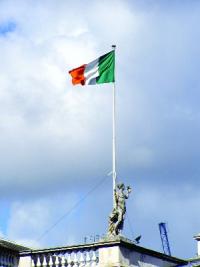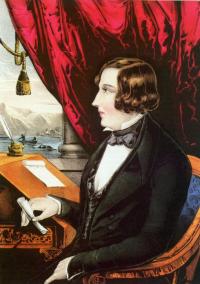1848 Tricolour Celebration
Published in 18th–19th - Century History, Issue 2(March/April 2011), News, Uncategorized, Volume 19
National flag of Ireland, seen here (below) flying over Dublin’s GPO

Thomas Francis Meagher—at the Wolfe Tone Club, Waterford, in March 1848 he unveiled the tricolour that would eventually become the national flag of Ireland, seen here (below) flying over Dublin’s GPO. (Currier and Ives)
In March 1848 a concerned mayor of Waterford, Sylvester Phelan, wrote to T.N. Reddington, under-secretary for Ireland, asking what action he should take in relation to an Irish tricolour hanging from 33 The Mall. The reply the mayor received is unclear, but records show that the flag was still flying ten days later. Thomas Francis Meagher had unveiled a tricolour that would eventually become the national flag of Ireland at the Wolfe Tone Club in Waterford.
Prior to this, the wearing of green, white and orange rosettes and cockades had started to become common in Ireland, as an expression of the dream of a united Irish people. The French tricolour also appeared in support of the concurrent revolution in France, an event that had greatly inspired the young Meagher. After Meagher’s innovation the Irish tricolour started to appear at rallies and bonfires across the nation.
In April 1848 Meagher and William Smith O’Brien travelled to France to seek support for their cause. Alphonse de Lamartine, head of the provisional government, was reluctant to provide direct support to the young idealists. The Young Irelanders returned from France with a fabulous silken tricolour, however, which they presented to the other members of the Irish Confederation on 15 April 1848. When asked the meaning of the flag, Meagher replied:
‘I trust that the old country will not refuse this symbol of a new life from one of her youngest children. I need not explain its meaning. The quick and passionate intellect of the generation now springing into arms will catch it at a glance. The white in the centre signifies a lasting truce between the “orange” and the “green” and I trust that beneath its folds, the hands of the Irish Protestant and the Irish Catholic may be clasped in generous and heroic brotherhood . . .’
John Mitchell, another Young Ireland leader, expressed the hope ‘to see that flag one day waving as our national banner’. The tricolour would not make another significant appearance until the Easter Rising of 1916, and this version was formally recognised as the flag of Ireland in 1937.
On Saturday and Sunday 5 and 6 March 2011, the events of 1848 will be remembered in Waterford City in the unifying spirit envisioned by Meagher and the Young Ireland movement and in the hope that the 1848 Tricolour Celebration will become an annual event. This year, on Saturday in Waterford’s Theatre Royal, economist, author and broadcaster David McWilliams and his carefully selected panel will present an interactive discussion about the impact of flags and emblems on politics and nationhood, the legacy of Thomas Francis Meagher’s tricolour, and what can be learned about our politics today and into the future. The show will also feature the outstanding comedy of Colm O’Regan and his ‘Facebook Guide to Irish Politics’.
On Sunday there will be a parade led by the Waterford-based Thomas Francis Meagher Marching Band and a naval colour party, followed by a flag-raising ceremony on the city’s Mall. The weekend will also include lectures, music, speeches and a warm Irish welcome to all who visit from abroad.
Enquiries: www.1848tricolour.com. HI
















